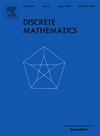Improved upper bounds for six-valent integer distance graph coloring periods
IF 0.7
3区 数学
Q2 MATHEMATICS
引用次数: 0
Abstract
Given a set S of positive integers, the integer distance graph for S has the set of integers as its vertex set, where two vertices are adjacent if and only if the absolute value of their difference lies in S. In 2002, Zhu completely determined the chromatic number of integer distance graphs when S has cardinality 3, in which case the graphs have degree 6. Integer distance graphs can be defined equivalently as Cayley graphs on the group of integers under addition. In 1990 Eggleton, Erdős, and Skilton proved that if an integer distance graph of finite degree admits a proper k-coloring, then it admits a periodic proper k-coloring. They obtained an upper bound on the minimum such period but point out that it is quite large and very likely can be reduced considerably. In previous work, the authors of the present paper develop a general matrix method to approach the problem of finding chromatic numbers of abelian Cayley graphs. In this article we show that Zhu's theorem can be recovered as a special case of these results, and that in so doing we significantly improve the upper bounds on the periods of optimal colorings of these graphs.
改进的六价整数距离图着色周期上界
给定一个正整数集S, S的整数距离图以整数集作为其顶点集,其中两个顶点相邻当且仅当它们的差的绝对值在S。Zhu在2002年完全确定了当S的基数为3时整数距离图的色数,在这种情况下图的度数为6。整数距离图可以等价地定义为加下整数群上的Cayley图。1990年,Eggleton, Erdős, and Skilton证明了有限次整数距离图如果允许适当的k-染色,那么它就允许周期适当的k-染色。他们得到了最小周期的上界,但指出它相当大,很可能会大大减小。在以前的工作中,本文作者提出了一种一般矩阵方法来求解阿贝尔凯利图的色数问题。在这篇文章中,我们证明了Zhu定理可以作为这些结果的一个特例而被恢复,并且这样做我们显著地改进了这些图的最优着色周期的上界。
本文章由计算机程序翻译,如有差异,请以英文原文为准。
求助全文
约1分钟内获得全文
求助全文
来源期刊

Discrete Mathematics
数学-数学
CiteScore
1.50
自引率
12.50%
发文量
424
审稿时长
6 months
期刊介绍:
Discrete Mathematics provides a common forum for significant research in many areas of discrete mathematics and combinatorics. Among the fields covered by Discrete Mathematics are graph and hypergraph theory, enumeration, coding theory, block designs, the combinatorics of partially ordered sets, extremal set theory, matroid theory, algebraic combinatorics, discrete geometry, matrices, and discrete probability theory.
Items in the journal include research articles (Contributions or Notes, depending on length) and survey/expository articles (Perspectives). Efforts are made to process the submission of Notes (short articles) quickly. The Perspectives section features expository articles accessible to a broad audience that cast new light or present unifying points of view on well-known or insufficiently-known topics.
 求助内容:
求助内容: 应助结果提醒方式:
应助结果提醒方式:


